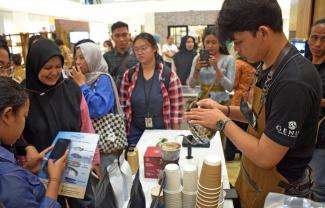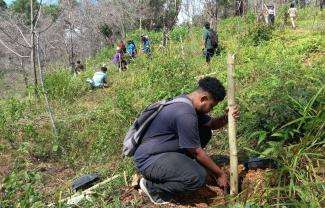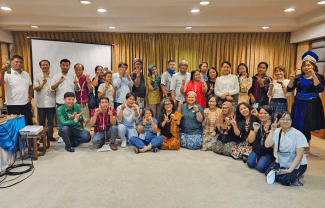The existing poverty conditions and high vulnerability of Tagbanwa communities in the Calamianes islands were aggravated with the impacts of STY Haiyan, especially in the recovery of basic food, water and income sources; and loss of shelter and valued possessions such as paddle boats and fishnets.
Samdhana facilitated early recovery for Tagbanwa communities, by providing direct livelihood assistance and small grants to the local Tagbanwa associations in their respective ancestral domains. The small grants approach enabled communities to determine and decide their priorities for recovery through community projects and provided more opportunities for the affected families and individuals to participate directly in the activities.
However, the local Partner Associations knew they needed more capacity-building to enable them to sustain their initiatives, and more importantly, to assert their rights as Indigenous Peoples and address the issues they face. They continue to be challenged by issues on the recognition of their right to their ancestral domains, the lack of capacity to assert land ownership, and accessing and controlling resources. They are continually at risk of getting pushed off from their residences and production areas if they are unable to secure formal government recognition of their ancestral domain especially in the face of aggressive tourism development and mariculture expansion.
Within Tagbanwa communities, intrinsic vulnerabilities due to unequal power relations between the tribe and non-IP communities and institutions, between women and men persist and manifest in access of opportunities, division of resources, allocation of labor and in decision-making on matters related to the management of their ancestral domains. This must be properly understood for the integration of disaster risk reduction and climate change adaptation into ancestral domain sustainable development and protection plans to be more inclusive. Disaster risk reduction and community adaptation can be vehicles towards addressing the basic issues and vulnerabilities of the Tagbanwa in the Calamianes.
For the whole project, we covered nine (9) Ancestral Domains, with a total of 17 Barangays, with three where only the sitio level only is involved. Total locations encompass three (3) municipalities.
Some of the significant outcomes are the following : Capacities of Tagbanwa communities are strengthened with tools of analyses that enable them to assess their own vulnerabilities, identify their capacities to prepare, respond, mitigate identified risks and adapt. Tagbanwa communities are able to develop appropriate DRR-CCA and/or Community Disaster Preparedness Action Plans, informed by their own analyses of inher.
 Mapping as a result of the Participatory Vulnerabilities and Capacities Assessment (PVCA). Photo by Samdhana
Mapping as a result of the Participatory Vulnerabilities and Capacities Assessment (PVCA). Photo by Samdhana
There were a total of 17 DRR-CCA Action Plans completed, from each of the community partners. These DRR-CCA Action Plans were formed, from a thorough series of conducting PVCA, community analysis of PVCA results and community planning. The whole process was community led, under the facilitation of PVCA Community Facilitators. Samdhana provided the localized PVCA training, and closely mentored the Community Facilitators.
The community DRR-CCA Action Plans identified the important steps to ensure their preparedness to any natural disasters. In particularly of high priority is the need to increase local capacities for basic life support, establishing early warning systems, and understanding the phenomenon on climate change and strategies for climate change adaptation.
Formulation of the Ancestral Domain Sustainable Development and Protection Plan (ADSDPP) are informed by community DRR-CCA Plan in at least 3 Ancestral Domains
With indigenous peoples rights as handle, Tagbanua of Calamianes are able to articulate and assert their basic human rights and collective rights as IPs especially in rehabilitation projects that are implemented in their ancestral domains i.e. relocation and rehabilitation programs, water and sanitation, hygiene projects, livelihood, reparation of damages and losses, documentation and registration.
The Paraigu was the first ever Calamianes-wide gathering where all the recognized leaders and Elders of all the Calamianes Tagbanwa communities came together to discuss the situation of the Tagbanwa in the current context and challenges. This meeting reinforced the sense of identity among the Calamianes Tagbanwa and strengthened the resolve to continue their pursuit of formal recognition of their ancestral domains and strengthening of Indigenous governance. Community working groups on governance and justice system, on natural resource management and disaster preparedness, and on women and youth empowerment were created.
Tagbanwa associations are recognized by the local government units. Avenues and platforms for Tagbanua representatives to engage with local actors and institutions are available and accessible leading to increased and active representation of Indigenous Peoples in Local Governance Special Bodies, especially in the barangay and municipal disaster risk reduction councils.








